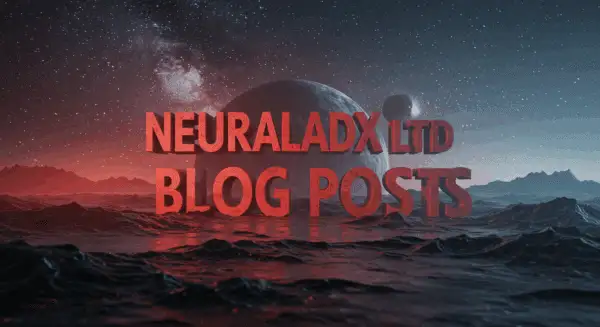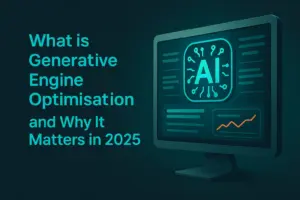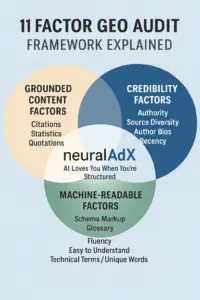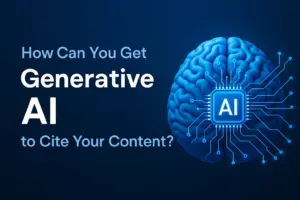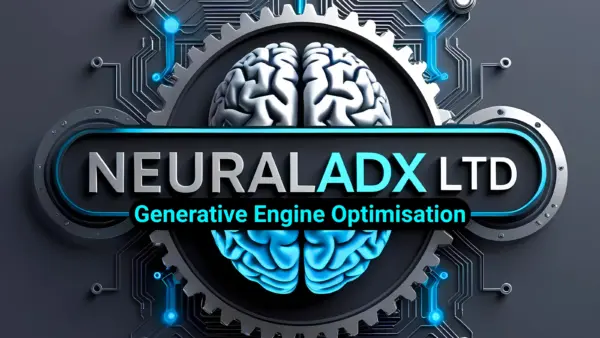What Is Generative Engine Optimisation (GEO) & Why It Matters in 2025
Table of Contents
Jump to any section below to find exactly what you need!
- Why GEO Matters in 2025 (3 min read)
- What Is GEO? (4 min read)
- GEO vs Traditional SEO (4 min read)
- How to Implement GEO Today (5 min read)
- Key Takeaways (2 min read)
- Frequently Asked Questions (5 min read)
- Glossary of Key Terms (2 min read)
- About the Author (1 min read)
- Ready to Get Started? (1 min read)
- Explore More
- Join the Conversation
Why GEO Matters in 2025
Short answer: Generative engines (ChatGPT, Gemini, Claude, Perplexity) now sit between your audience and your website. To be discovered, you don’t just “rank”—you must be cited inside AI answers. That’s Generative Engine Optimisation (GEO).
Evidence keeps stacking up. A March 2025 analysis from Pew shows that when Google displays an AI summary, users are less likely to click links to other sites (Pew Research). Industry data also shows zero-click searches rising and organic clicks falling year-over-year in both the U.S. and EU/UK (Search Engine Land). Meanwhile, AI platforms referred 1.13 billion visits in June 2025—up 357% year-over-year (Similarweb).
Why this matters?
Search is changing as users are migrating over to AI generative engine search tools which favour generative engine optimised content.
Watch Our Video Guide:
Summary transcript: This short video explains why generative engine optimisation matters as users are now using AI chat bots like ChatGPT, perplexity, Microsoft Co-Pilot and Google AI Mode instead of the traditional search engines. End of transcript.
Infographic: GEO at a Glance
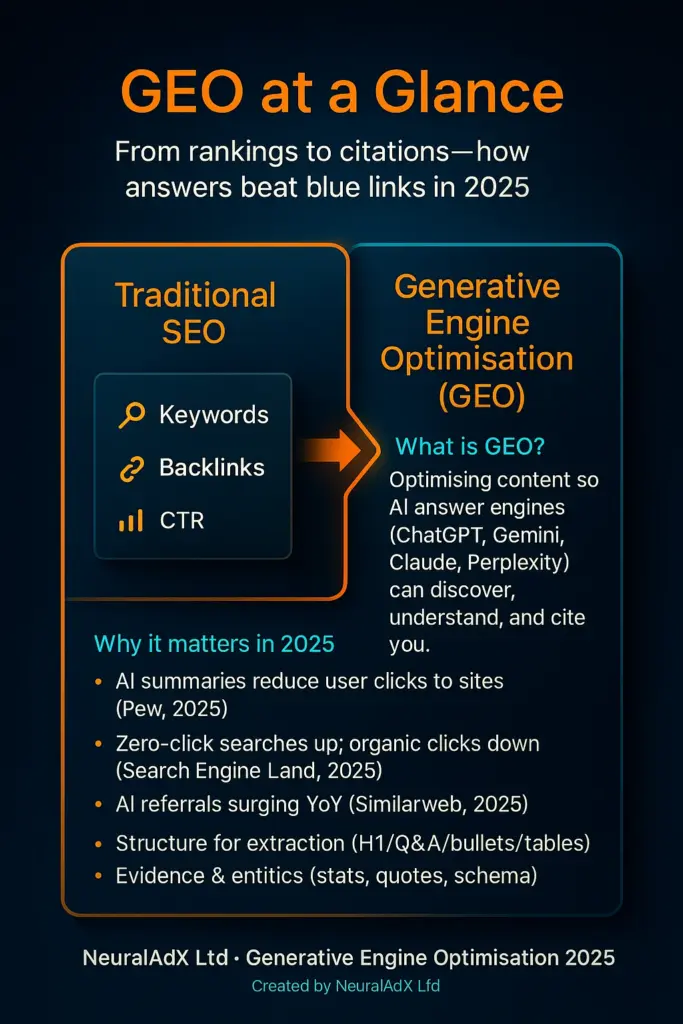
This visual shows the shift from blue links to answer snippets, highlighting citation signals (structure, sources, schema).
| Feature | Traditional SEO | GEO (Answer Engines) |
|---|---|---|
Primary Goal |
Rank pages, drive clicks |
Be cited inside AI answers |
| Signals | Keywords, backlinks | Authority, structure, entity clarity, schema |
Measurement |
Rankings & organic traffic |
Citation frequency & prompt coverage |
• AI summaries reduce link clicks (Pew).
• Zero-click behaviour is rising (Search Engine Land).
• AI referrals are growing fast (Similarweb).
What Is GEO?
Definition: Generative Engine Optimisation is the practice of structuring content so generative systems can find it, understand it, and cite it in answers. The Princeton team that coined “GEO” showed visibility can increase by up to 40% using creator-centric optimisation techniques (Princeton, GEO paper).
“We introduce Generative Engine Optimization (GEO)… to improve content visibility in generative engine responses.” — Aggarwal et al., Princeton
The following video provides a deeper understanding of GEO:
Summary transcript: This video explains how generative engine optimisation structures your content so it will align with AI generative engines preferred criteria. This significantly increases your chances of being the AI-generated answer to a users query.
Diagram: The Answer Layer…This additional infographic explains how AI generative engines process information to help highlight the role of GEO.
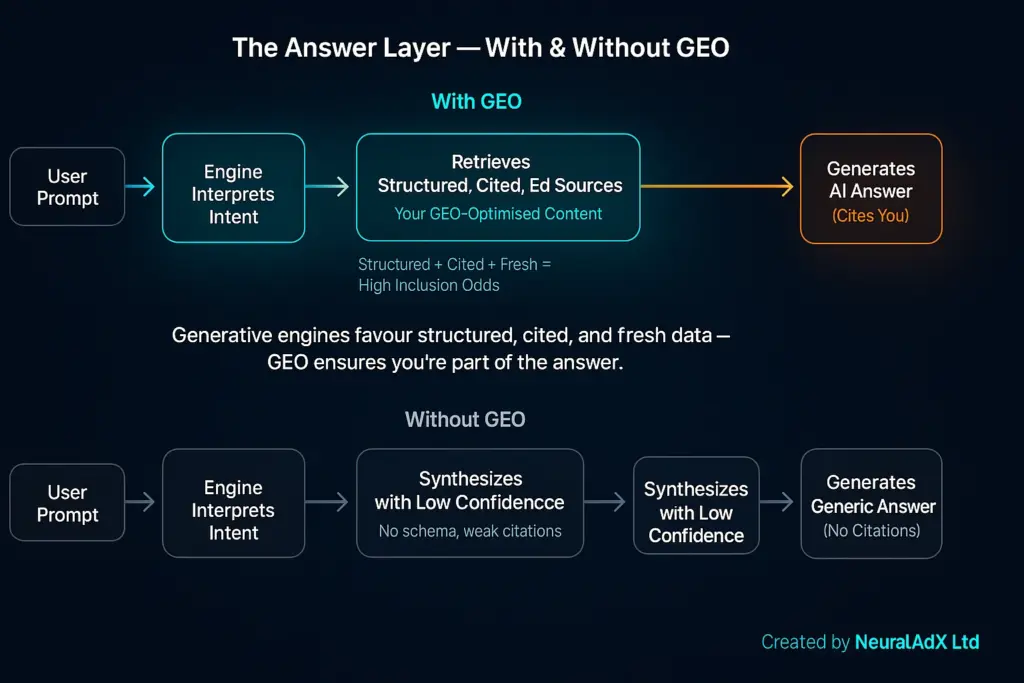 The Answer Layer — With and Without GEO. Generative engines favour structured, cited, and fresh data. GEO ensures your content is part of the AI answer layer and gets cited across ChatGPT, Perplexity, Copilot, and Google AI Mode.
The Answer Layer — With and Without GEO. Generative engines favour structured, cited, and fresh data. GEO ensures your content is part of the AI answer layer and gets cited across ChatGPT, Perplexity, Copilot, and Google AI Mode.
What’s new in 2025 is scale and user behaviour: Google’s AI Overviews and chat interfaces change how results are consumed. Analyses report that when AI Overviews are present, click-through rates to publishers fall sharply (Ars Technica). Similarweb also finds AI referrals to sites are small compared with Google but rising fast, with distinct categories benefiting (Similarweb).
GEO vs Traditional SEO
Mindset Shift
- From keywords to questions: Optimise for natural-language prompts, not just head terms.
- From rankings to inclusion: The KPI is being named in the answer.
- From links to proof: Stats, quotes, authorship, and schema act as trust multipliers.
“From keywords to context” is the shift B2B marketers must plan for as AI-powered search rewrites discovery. — Forrester
Chart: Traffic Reality Check
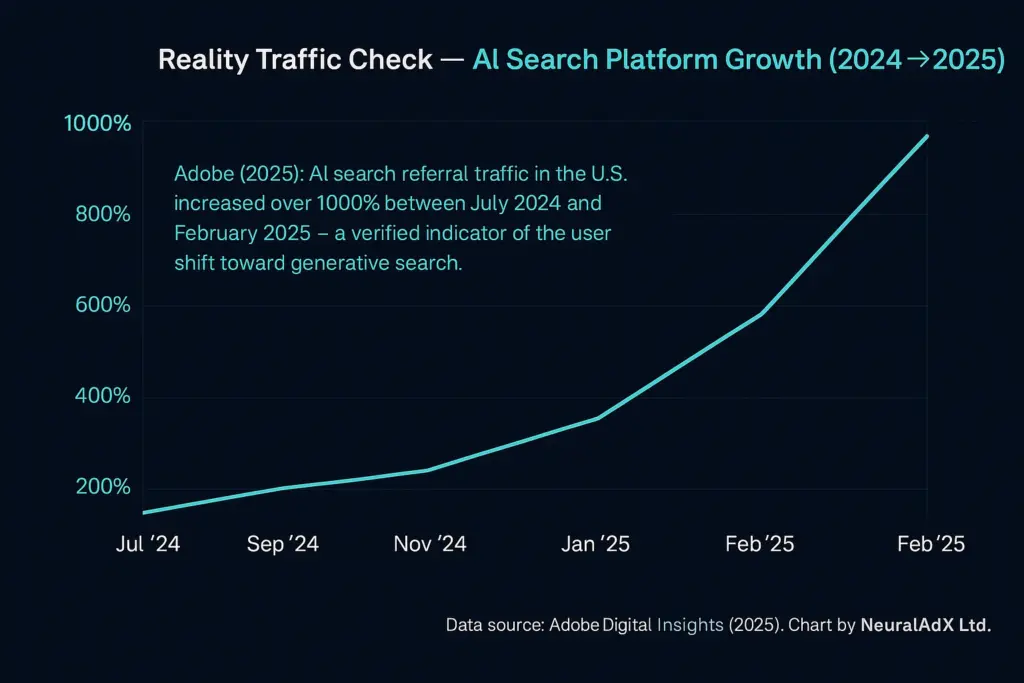
Reality Traffic Check — Adobe (2025) confirmed AI search referral traffic grew over 1000 % in the US from 2024 to 2025, proving the global shift toward generative search. Chart by NeuralAdX Ltd.
Concrete numbers showing more examples of AI search increasing:
- EU/UK organic clickers fell from 47.1% (Mar 2024) to 43.5% (Mar 2025); zero-clicks rose to 26.1% (Search Engine Land).
- AI platforms generated 1.13 bn referral visits in June 2025, up 357% YoY (Similarweb).
- McKinsey estimates gen-AI could add $2.6–$4.4 trillion annually across use cases (McKinsey).
Implications
- Re-score content for citation readiness (structure, sources, schema, freshness).
- Measure AI citation frequency, not just sessions.
- Build clusters: hub page (evergreen) + supporting posts (timely, deep dives).
How to Implement GEO Today
1) Audit AI Visibility
Identify priority prompts you should own. Test in ChatGPT, Perplexity, Gemini. Note if/when your brand is cited. Track competitors that do appear. Legal and market noise (e.g., lawsuits over AI Overviews) underline why you must control your “answer presence” (The Verge).
2) Structure for Extraction
- Lead with the answer; support with detail.
- Use Q&A blocks, bullets, and short paragraphs.
- Add specific stats and quotes with links.
- Mark up with Article/FAQ schema (developer comment below).
“Generative engines are here to stay… we must ensure creators aren’t disadvantaged.” — (Princeton GEO paper)
Diagram: Page Anatomy for GEO
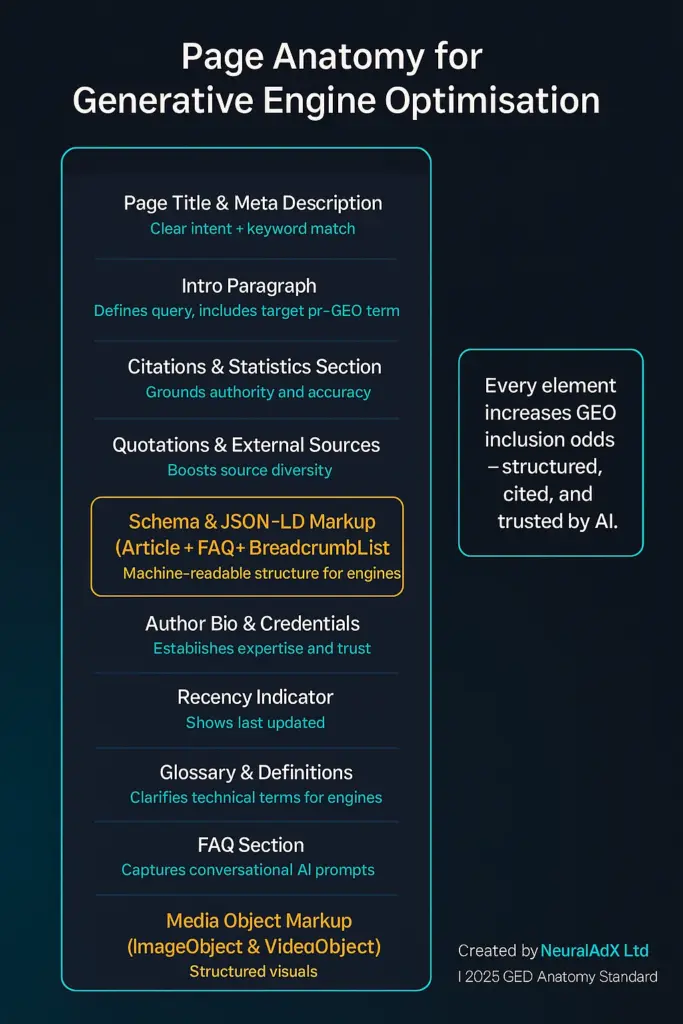
Page Anatomy for GEO — Every layer of a web page, from schema markup to citations and media objects, increases inclusion odds in AI search answers. Created by NeuralAdX Ltd | 2025 GEO Anatomy Standard.
3) Build Authority Signals
- Include 5–7 credible stats (Pew, Similarweb, McKinsey, Search Engine Land).
- Use 3–5 expert quotes (Forrester, Princeton, analyst blogs). Keep quotes short.
- Show authorship (bio, headshot, organisation).
AI referrals are small but high-intent in some categories; industry press notes rising platform usage and shifting loyalty among chatbots (TechRadar citing Similarweb).
4) Add Schema & Entities
- Article + FAQPage + BreadcrumbList.
- Use organisation/person nodes; wire about/mentions entities.
- Keep timestamps ISO 8601 (Zulu “Z”).
Generative systems lean on structure and entities—give them both. Gartner/Forrester commentary stresses the shift from keyword lists to context and knowledge (Forrester; Gartner).
5) Measure & Iterate
- Track presence in AI answers by prompt theme.
- Refresh facts quarterly; update quotes/stats.
- Interlink: point from this post to your hub, proof page, and pricing.
Internal links: GEO Service · Proof: GEO Works (Video) · GEO Pricing (UK)
Key Takeaways
- What is GEO? Optimising so AI engines cite your content in answers.
- Why now? AI summaries cut clicks; zero-click searches are rising (evidence).
- How to win? Structure, sources, schema, entities, and freshness.
- KPI shift: Measure citations and prompt coverage, not just sessions.
- Cluster power: Hub page + posts = authority LLMs can ground on.
For a deeper dive, see our GEO Service page.
Frequently Asked Questions
Does GEO replace SEO?
No—GEO complements SEO. You still need crawlability and links, but inclusion in AI answers demands structure, sources, and schema (Forrester).
Are AI Overviews hurting publisher clicks?
Multiple analyses indicate lower click-through when AI summaries appear (Pew; Ars Technica).
Is AI referral traffic meaningful yet?
Still smaller than Google, but growing fast: 1.13 bn AI referrals in June 2025, up 357% YoY (Similarweb).
What counts as a “citation” in GEO?
Being named or linked as a source inside an AI answer. The Princeton study formalises ways to improve this visibility (Princeton).
What structure helps LLMs?
Clear headings, short paragraphs, Q&A, lists, tables, and verifiable sources with links. Add Article/FAQ schema and entity signals (Forrester).
Do quotes and stats really matter?
Yes. They are machine-recognisable “proof points.” Keep them current and from reputable sources (Pew, Similarweb, McKinsey) (McKinsey).
Where should I start?
Run an AI visibility audit, pick priority prompts, structure your pages, inject schema, and track citations. We can help (NeuralAdX Ltd).
Glossary of Key Terms
- GEO: Optimising content to be cited by AI answer engines. Pro Tip: Lead with a concise definition.
- Answer Engine: Systems that return synthesized answers (ChatGPT, Perplexity). Pro Tip: Optimise for inclusion.
- AI Overview: Google’s summary box that can reduce clicks. Pro Tip: Become a cited source.
- Zero-click: Search with no outbound click. Pro Tip: Prioritise citations and mentions.
- Entity: A distinct “thing” (brand, person, concept). Pro Tip: Use consistent names and IDs.
- Schema: Structured data (JSON-LD) machines parse. Pro Tip: Article + FAQ + Breadcrumbs.
- Prompt Coverage: Share of tested prompts where you appear. Pro Tip: Track monthly.
- Topical Cluster: Hub + spokes that cover a theme. Pro Tip: Link both ways.
Ready to Get Started?
Own the answer layer. Get a fast, honest audit of your current AI visibility and a practical playbook to win citations in 90 days.
Explore More
- Generative Engine Optimisation Service: What’s included and how we deliver results.
- Proof That GEO Works Video: Live recording and screenshots.
- GEO Pricing in the UK: Packages and VAT details.
Join the Conversation
What’s your biggest GEO challenge right now—measurement, structure, or schema? Drop a comment or reach out for help.
